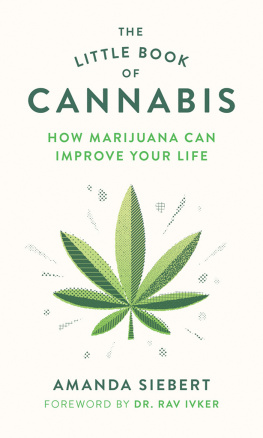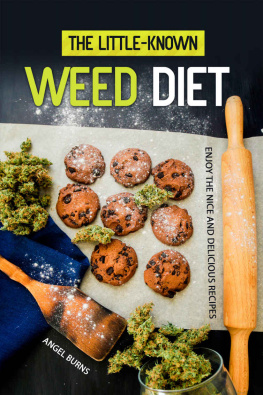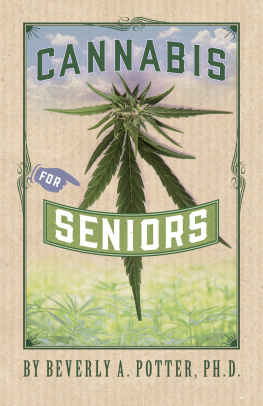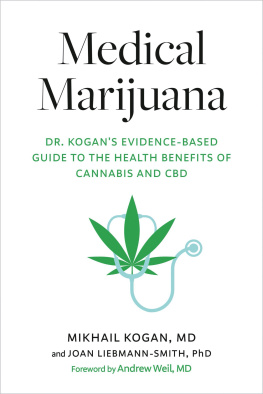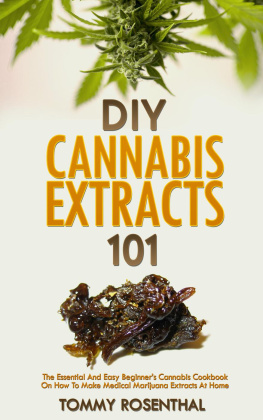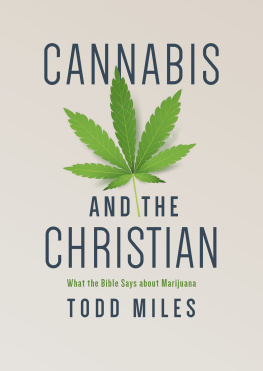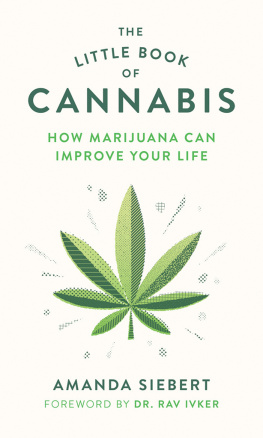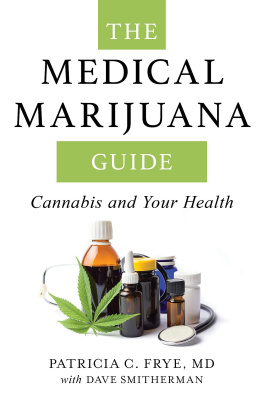
To the patients who are suffering, the enthusiasts standing up to adversity, the activists decrying unjust laws, and those doing time for victimless crimes: this book is for you.
CONTENTS

DISCLAIMER

THIS BOOK IS not intended to be a substitute for medical advice from physicians. The reader should regularly consult a physician about matters relating to their health, and particularly with respect to any symptoms that may require diagnosis or medical attention. While this book may mention specific product types, cannabis strains, cannabinoids, consumption methods, and so forth, the author and publisher recommend that readers notify their physicians if they are thinking about consuming cannabis for medicinal purposes.
Although the author and publisher have made every effort to ensure that the information in this book was correct at press time, they do not assume, and hereby disclaim, any liability to any part for any loss, damage, or disruption caused by errors or omissions, whether such errors or omissions result from negligence, accident, or any other cause.
The state of cannabis research is changing, and with the renewed interest in this plant, it is being studied more rigorously. As such, future research on the topics mentioned may come to conclusions that are contrary to what has been printed in this book.
Please consult local laws for the minimum age for cannabis use and other restrictions.

FOREWORD

T HIS HIGHLY INFORMATIVE book provides readers, first-timers as well as experienced consumers, with an excellent practical introduction to the multifaceted life-changing benefits of cannabis.
Retail sales of cannabis began in Canada on October 17, 2018, making it the second nation in the world, after Uruguay, to legalize the herb for recreational use. Since 2001, medical marijuana has been legal in Canada, as it is in the majority of U.S. states, at time of writing, with an ever-increasing number also approving the use of recreational cannabis. This rapidly accelerating trend is reversing nearly a century of prohibition of a powerful medicinal herb used throughout the world both medically and spiritually for more than five thousand years.
However, as a result of its illegality, its criminalization, and the lack of knowledge about the circumstances that led to its prohibition, as well as disapproval among the medical establishment, the majority of the worlds current population understandably remains skeptical. In addition, there has been a relative lack of reliable evidence-based information to dispel the myths and misconceptions surrounding cannabis. The Little Book of Cannabis helps significantly to fill that void.
As a holistic physician and cannabis clinician, I have used medical marijuana with more than eight thousand patients to relieve their suffering. From both my professional and personal experience with cannabis, spanning more than five decades, I strongly support the material presented by Amanda Siebert. Whether the chapter is discussing the use of cannabis for insomnia, anxiety, pain, inflammation, cancer, creativity and sexual pleasure, or end-of-life care, the author offers valuable and accurate information. I enjoyed her real-life compelling case studies, which correlated well with many of my patient stories.
By far the most frequent use of cannabis as a medicine, and its greatest therapeutic benefit, is the relief of chronic pain. This is certainly true of my practice, as more than 90 percent of my patients suffer with some degree of persistent pain. I found cannabis. Siebert did a superb job of researching this topic, drawing heavily on recent studies, historical references, and the work of Dr. Mark Ware, an associate professor in family medicine and anesthesia at McGill University in Montreal and the director of clinical research at the Alan Edwards Pain Management Unit at the McGill University Health Centre.
As a physician, I found the scientific references to be of particular interest, and they added to my knowledge base. The book is very well written, well researched, concise, yet comprehensive in its scope of cannabis-related quality-of-life benefits. Cannabis is a complex herb containing more than two hundred compounds. Siebert is able to simplify its complexity and provide explanations at a level that can be easily understood by most readers. As a result, The Little Book of Cannabis is an excellent guide for anyone interested in using this remarkable herb to heighten their enjoyment of life.
DR. RAV IVKER
AUTHOR, CANNABIS FORChronic Pain
COFOUNDER AND FORMER president, American
Board of Integrative Holistic Medicine

INTRODUCTION

W HILE MY AGE of introduction to cannabis might send a shudder down the spine of any lawmaker considering the pros and cons of cannabis legalization, the stigma associated with youth use is one of the reasons I feel the need to share my experience. At age fourteen, while taking a break from staffing the merch table at a local punk show in my hometown of Richmond, B.C., I tried cannabis for the first time. I had been curious about the strange weed that my parents had cautioned me to avoid, but when my older friends said it helped them feel relaxed, I figured my parents were wrong and, like so many teenagers do, I decided I had to find out for myself if cannabis would indeed fry my brain cells. Seated atop a picnic table with two girlfriends, I indulged in a hoot and a half from a pipe, which resulted in a momentary fit of laughter but nothing more. After that first encounter, I used cannabis occasionally in social settings with friends, but it wasnt until college that I began to discover how using it brought me direct and indirect benefits in other areas of my life.
I remember walking into a friends house for the first time during my second year of college and seeing him point to a set of roach clips on the table. (For the uninitiated, these are used to hold a joint when it gets too short to smoke holding it with your fingers.) I remember thinking, Wow, this weed stuff can get pretty hardcore. I wont lie; there was a little judgment thereand then I got high. From that point on, everything changed.
It wasnt long before I began to appreciate cannabis for its ability to stoke conversation at social gatherings and calm me down after a week of late nights spent meeting tight deadlines. Friday and Saturday evenings were often spent steeped in bubbles of intelligent thought and clouds of cannabis smoke as my friends and I waxed poetic about our studies, current events, and pop culture, often opting for doobies over booze in the interest of avoiding the next days hangover. Soon, when assignments started to pile up, part-time shifts at work gobbled up my free time, and arguments with my mother (sorry, Mom) took me to the edge, cannabis would bring me to a place where all the seemingly impossible tasks of the day could be tackled with a puff and a simple shift in perspective.

